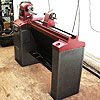Thanks, Leo. It's good to have advice on the grease from someone who has worked with this kind of machine. Keeping it in working condition is my #1 priority. When I get it moved, I'll do like you say and open it up and clean it out and see what's in there. When I start using it, I'll have to remember to make greasing the bearings part of my routine.
I dug out the stuff in front of the tailstock and pulled it out. The good news is that the headstock and tailstock seem to have the same taper. The bad news is the live center that was in the tailstock doesn't fit. It sticks about halfway out.
Attachment 318498
(Please excuse the flash - it was after dark and there's no electricity out there.)
Going by what I measured (5/8"), I'm going to guess it's a Jarno #5 taper. That's just a guess, though. It seems to fit the time period, and there's a lot of dead centers for those on ebay that had to come from somewhere.
I'll probably go with my original plan of putting something in the taper to measure it. Not plaster though - both tapers bottom out, so plaster would be hard to remove intact. Besides, the tailstock weighs a ton and I'm not comfortable trying to get it to stand on the wheel on a concrete floor - it'd be just my luck to drop it and crack it in half.
While I do like the fact that it's an antique machine, I'm awfully tempted to have both sides reamed to 2MT. It'd really simplify things for me.
Here's some better pictures of the tailstock, now that I've dug it out:
Attachment 318499Attachment 318500
The knob is indeed the locking knob. It works fine. One thing I noticed - if I back the tailstock in all the way, the wheel keeps going but the tailstock starts turning. When that happens, you can't make it come back out without tightening the top knob. I found this out accidentally - I've seen videos where people eject their centers by retracting the tailstock all the way. That didn't work for me (must be a feature on newer lathes - the tailstock only retracts so that it's flush with the casing), but a couple light taps with that clamp sitting next to it popped it out fine.





 Reply With Quote
Reply With Quote





